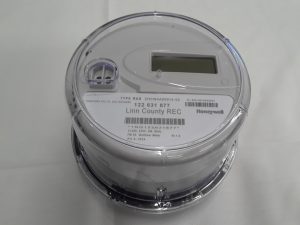5 Smart Meters

An example of a smart meter is shown in the above photo.
A smart meter serves two primary functions: 1) providing data to customers so that they can control consumption and costs; and 2) providing data to the utility for billing, power factor data, peak load data, and troubleshooting data. The data provided to the utility can be analyzed by metadata software so that it can determine the devices a customer is running throughout the day. Furthermore, this data allows the utility to better determine when peak loads may occur. Peak loads are the most expensive for a utility to meet. The peak load data can also be used by the utility to encourage customers to use power at off-peak times or at high alternative energy generation time periods(Momoh 22).
The first large scale adoption of smart meters was by EnelSpA in Italy between 2000 and 2005 when over 27 million customers received them (Righter 77). In Iowa Linn, Country Rural Electric Cooperative has installed smart meters for all of its members. The photo above is the type of meter that was installed.
Works Cited
Momoh, James A. Smart Grid: Fundamentals of Design and Analysis. IEEE Press, 2012.
Righter, Robert W. Windfall: Wind Energy in America Today. University of Oklahoma Press, 2011.

